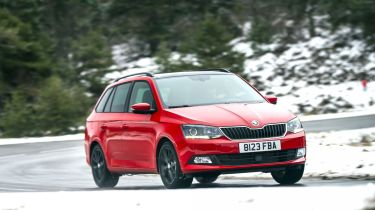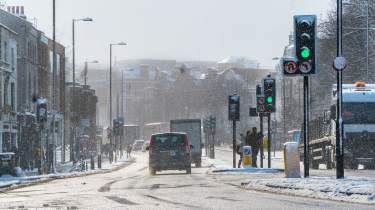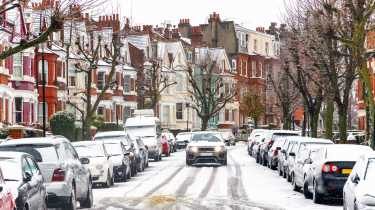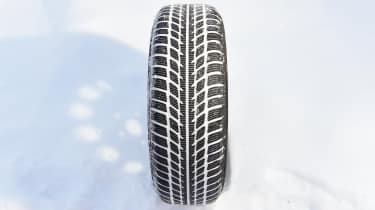Driving in snow and ice: top winter driving tips
When the temperature begins to plummet, it’s important to know how to drive safely

There’s more to driving in winter than just turning up the heated seats and sticking on your favourite Christmas playlist. Snow and ice make for tricky driving conditions, so it’s important to know what precautions to take to ensure you stay safe on the road.
What makes snow and ice so dangerous? It comes down to grip. Your tyres need to be able to grip the road to get your car round a corner or to come to a stop. Fresh snow can be quite grippy, but as soon as it gets compacted or starts turning to slush, it can get very slippery and dangerous. Patches of ice can cause your car to slide if you’re not careful, and black ice can be very dangerous and difficult to spot when driving.
If you’re not confident to drive in snow or ice, the safest thing to do is not to drive at all. All the main weather apps show local weather warnings when they’re in place, and give advice about driving in inclement weather.
If the wintry conditions are safe enough for driving, there are several things you should be aware of to make sure you get to your destination safely. Keep reading for our guide on how to drive in snow and ice. We’ve also covered the best cars for winter if you’re looking for a new set of wheels to get you through the cold.
Keep your speed low
The best and easiest way to keep safe when driving in snow, ice and rain in winter is to slow down. Driving slowly will make it easier to keep your steering, throttle and braking inputs smooth, which is vital for maintaining traction when grip is reduced. Travelling at a slower speed also gives you more time to react to any corners, traffic lights or other cars ahead. This is important, as snow and ice will greatly increase your braking distance, and you will need to leave a much greater gap to the traffic ahead.

If the snow is quite deep, it’s often better to drive on fresh snow than the compressed tracks left by other vehicles, as you should find more grip, helping to provide better control over braking and steering. Be mindful of how deep this is, however, as you don’t want to sink into a snowdrift or hidden gutter.
Drive smoothly
When grip is reduced by snow or ice, all of your inputs should be smooth and gradual. Any sudden inputs with the accelerator, brakes or steering can cause the tyres to lose grip on the road surface, and you could skid and lose control of the car.
A larger gap to the car in front will give you longer to react to problems ahead and allow you to brake much more gradually. In snow, it’s also advisable to change down through the gears to slow the car (or use regenerative braking in electrified cars), rather than solely using the brakes. Treat the steering sensitively, too – sudden manoeuvres can cause you to go straight on instead of turning (understeer) or even spin, where the back of the car tries to overtake the front (oversteer).
What to do if you slide in the snow
Firstly, never panic at the wheel. It’s usually possible to recover from a slide on snow or ice, as long as you do the right thing.
If you try to turn a corner, but the front tyres are slipping and the car won’t turn, straighten the steering wheel. You should ease off the brake and accelerator, too. It might sound odd, but this is the best way to regain grip, at which point you can regain control.

If the tail of the car starts to slide out wider than the front, you should also gently ease off the accelerator and brake. Steer into the slide – meaning, steer in the direction that the rear wheels are sliding out. This keeps your front wheels aligned with the car’s path, helping it straighten out. This will allow you to regain control, when you can then gently apply the brakes.
If you start to slide, never brake or accelerate sharply, as this will exacerbate the slide. Keeping your inputs smooth is vital for regaining control.
Reduce chance of skidding by using higher gears
Driving in higher gears than usual can make it easier to make progress in snow and ice. This is because less pulling power – known as ‘torque’ – reaches the wheels, making them less likely to spin.
Try pulling away in second gear instead of first and then change up slowly and steadily at a lower RPM than normal. You’ll need to be cautious, though – cars can pick up a lot of speed in higher gears, even without pressing the accelerator pedal.
Of course, this doesn’t apply to most automatic cars. Some automatic cars will have a manual gearshift mode, but it’s often best to leave it to its own devices and focus on the road instead.
Winter tyres
The best upgrade you can make to your car when it gets icy is a set of good winter tyres. They’re compulsory in many European countries during winter time, and even though they’re not a legal requirement here, their benefits can’t be understated. Even a front-wheel-drive family car fitted with winter tyres is safer and more capable in snow and ice than an all-wheel-drive SUV fitted with normal tyres.

Winter tyres are specially designed to work when the temperature is seven degrees Celsius or lower, so they’re not just for snow and ice. They improve stopping distances in wet and slippery conditions, but don’t provide as much grip as normal tyres when temperatures are higher, so we don’t recommend keeping them on all year.
The biggest hurdle is the cost of an extra set of tyres. But if you plan to be on the road over winter, they could make the difference between making safe progress, getting stuck or even worse, having an accident. Of course, while your winter tyres are fitted, you’re not wearing out your regular tyres, so they should have to be replaced less often. It’s worth remembering that winter tyres will need storing in summer, and vice versa.
Make sure to read our guide to winter tyres if you’re thinking of getting some.
Driving in poor weather conditions
Snow and ice is pretty rare in the UK, at least compared to some other parts of Europe. Winter isn’t just about freezing temperatures; fog, heavy rain and wind can all cause problems and make driving more difficult, while roads may be slippery due to leaves and mud. Glare from a low sun can be dangerous too. Read our guides to driving through fog and flooding to make sure you know how to face these conditions.
Preparing your car for the winter
It’s never worth skimping on car maintenance but during the winter months its condition is all the more important in giving you the best chance of beating the elements. Our winter car checklist is a step-by-step guide about what to check on your car, whether you’re a beginner or an expert.
The key areas to check are tyres (tread depth and pressure), screenwash, antifreeze, oil, wipers, lights and the battery – the guide gives all the information you need. If you’d like some extra piece of mind, many garages offer a ‘winter health check’ for about £15-20.
You’ll also want to remember your car will get far dirtier in winter. While a full clean might seem futile – as the car instantly gets dirty again – it’s a good idea to carry a cloth or paper towels to ensure your side windows, headlights and number plates aren’t covered in grime. If they are, it’ll impair your safety and driving with obscured number plates is an offence.
You may also want to give the door sills a wipe, as there’s nothing worse than getting in or out of the car only to find a smear of mud on your trouser leg or dress. With so much mud around, it can also be handy to buy a set of durable car mats just for winter use.
Carry an emergency kit
While carrying an emergency kit might seem over the top, if you ever need it you’ll be very glad you had the foresight. Once prepared, you can also keep the same kit for many years, only replacing perishables and batteries. We recommend including:
- A warning triangle to alert traffic if you break down or have to stop
- Hi-vis vests or coats for all occupants, not just the driver
- A first-aid kit
- De-icer spray and an ice scraper
- A small shovel
- A tow rope
- Wellington boots
- A torch and fully charged batteries
- Warm clothes
- Food and drink
- Phone charger
- Screenwash and engine oil
Read our guides to the best winter cars and best 4x4s and SUVs on sale if you’d like a capable new car for winter
Most Popular

New Smart #5 Brabus is a 637bhp far cry from the brand’s city car past

Best car leasing deals 2025: this week’s top PCH offers
Tips & advice

Car dashboard warning lights: what does each symbol mean?

Electric car charging stations: public networks, charger types, apps and maps






